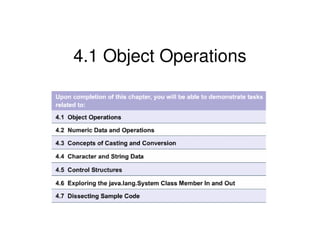
Chapter4
- 2. 4.1.1 operators • Dot ( . ) and new operate on objects • The assignment operator ( = ) • Arithmetic operators + - * / % • Unary operators ++, --, *=, %= • Operator precedence • Arithmetic expressions are left associative • Assignment operators are right associative
- 3. 4.2.6 Boolean data and comparison operators • boolean values are true or false ( not 1 or 0) • Less than <, greater than >, equal to ==, less than or equal to <=, greater than or equal to >=, not equal != • AND &, OR |, XOR ^ • Short curcuit AND &&, OR ||
- 4. 4.2.8 Conditional operator • Alternative for if - else y = x > 4 ? 99: 9; Is the same as: if(x > 4) y = 99; else y = 9;
- 5. 4.2.9 Bitwise operators • Perform shifting of bits on integral types, preferably int of long • <<3 shifts all bits left 3 places. All new bits are 0 • >>>3 shifts all bits right 3 places. All new bits are 0 • >>3 shifts all bits right 3 places. The new bits are the same as the most significant bit before the shift.
- 6. 4.3.1 Casting and conversion • Casting assigns a value of one type to a variable of another type • If it is possible to lose information, an explicit cast is required long bigValue = 99L; int squashed = (int)bigValue;
- 7. 4.4.2 String and StringBuffer class • The String object can be used to store an arbitrary number of textual characters • Strings are immutable: They do not change • Concatenating two Strings results in the creation of another String • Use StringBuffer to hold Strings that will change
- 8. 4.5.1 Decision making and repetition • Control structures control the flow of statement execution • Three control structures: Sequence, selection or decision, repetition • In OOP, control structures exist within methods only • Selection control structure provides conditional execution (if-else) • Repitition control structure causes the computer to repeat certain actions (for <loop>, while <loop>, do <loop>)
- 9. 4.5.3 If statement • Basic if(x == 3) { System.out.println(“x equals 3”); } else { System.out.println(“x does not equal 3”); }
- 10. 4.5.4 Multiple condition If • Multiple condition if(a < b) { System.out.println(“a is less than b”); } else if (a < c) { System.out println(“a is less than c”); } else { System.out.println(“a is not less than b or c”); }
- 11. 4.5.5 Nested if • Nested If if(x == 3) { System.out.println(“x equals 3”); if( y == 4) { System.out.println(“ …and y equals 4”); } } else { System.out.println(“x does not equal 3”); }
- 12. 4.5.6 Switch statements • A conditional control structure that allows a value to be compared to more than one other value switch(test) { case 1: System.out.println(“test equals 1”); break; case 2: System.out.println(“test equals 2”); break; case 3: System.out.println(“test equals 3”); break; default: System.out.println(“test does not equal 1, 2 or 3”); break; }
- 13. 4.5.7 Loop • do while: Execution loops. Conditional evaluation at the end of the loop • while: Execution loops through the block. Conditional evaluation occurs at the start of the loop • for next: Specifies an initialization block, a conditional evaluation and a block that is executed in every loop
- 14. 4.5.11 Use of break, continue, and label • break is used to exit a block • continue is used to return to the start of the loop • label can be applied to a statement or block, then used with continue or break • break can be used to exit a labeled block • continue can be used to resume at a statement
- 15. 4.6.1 The java.lang.System class
